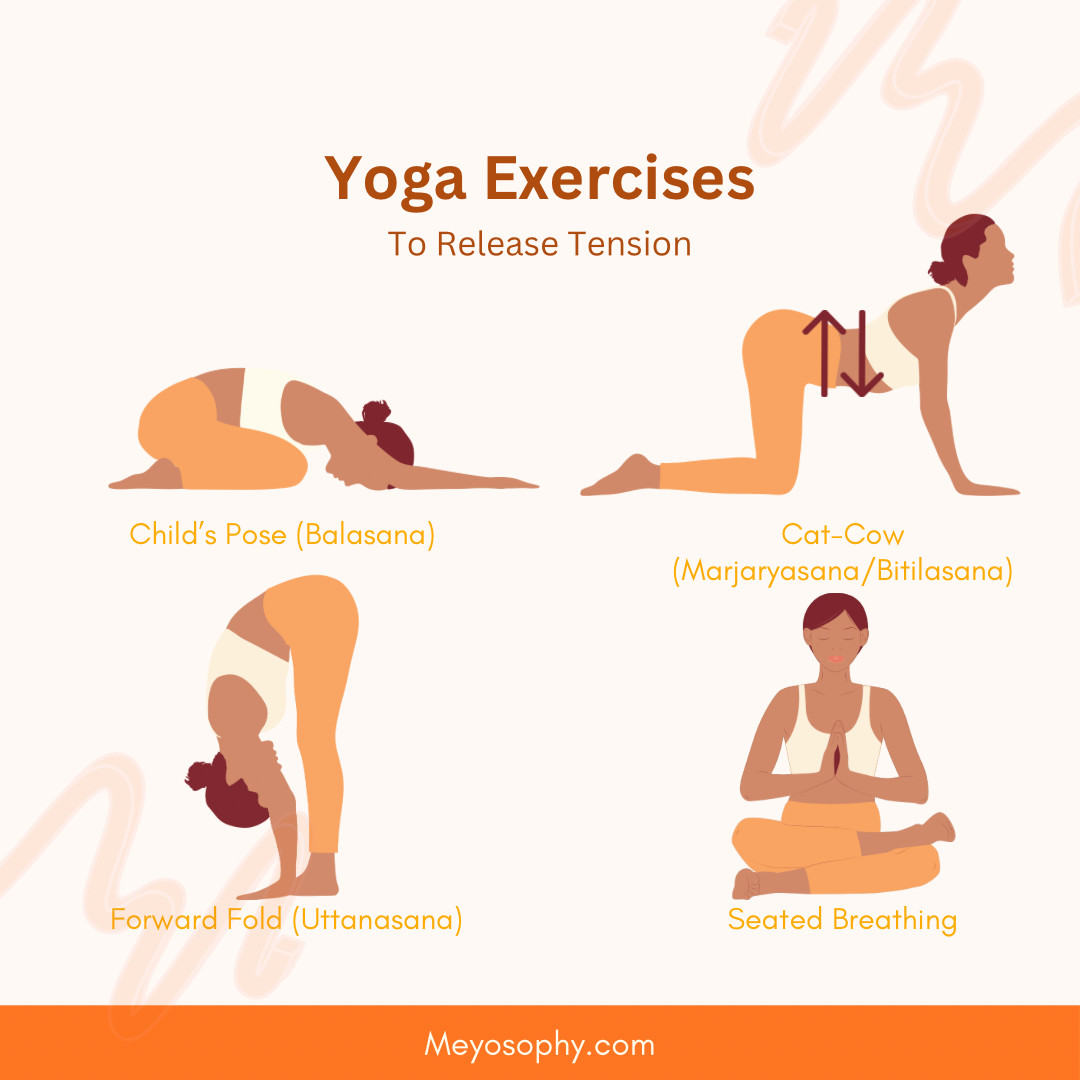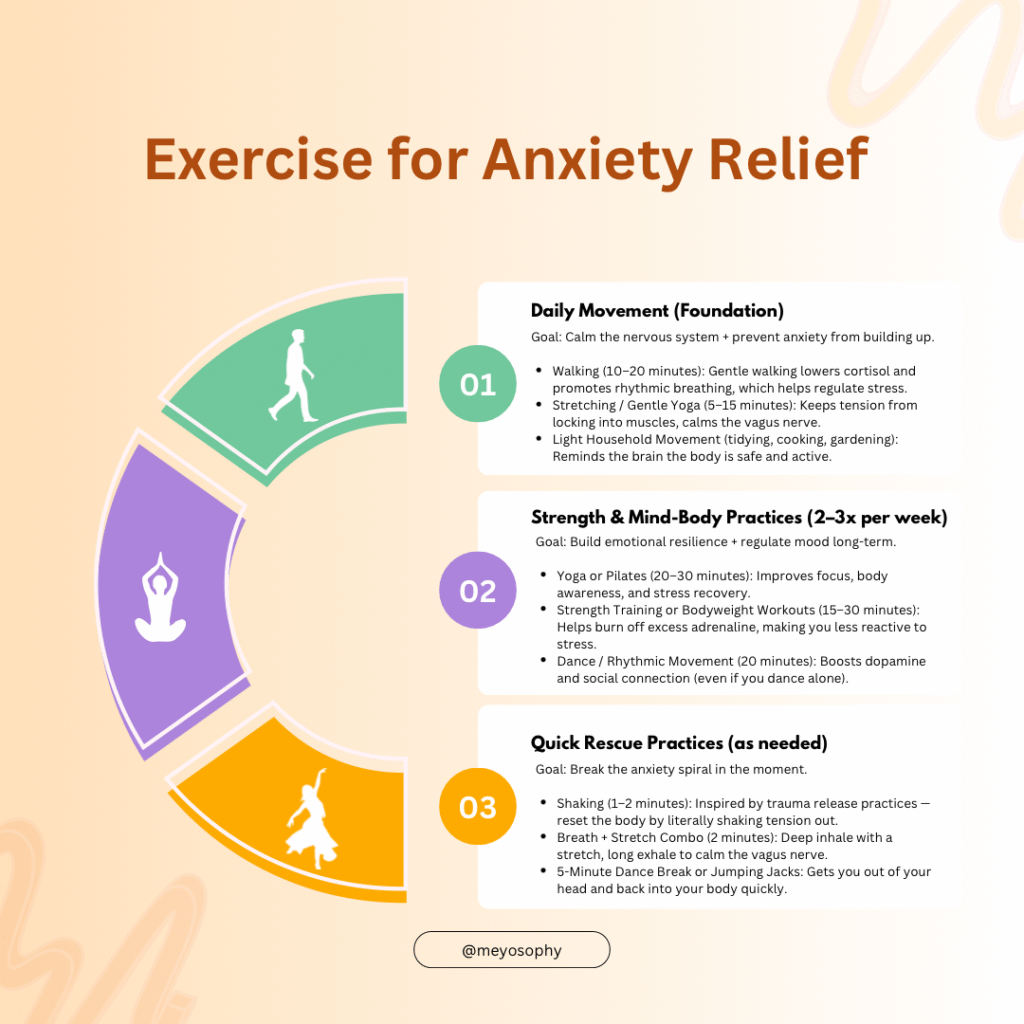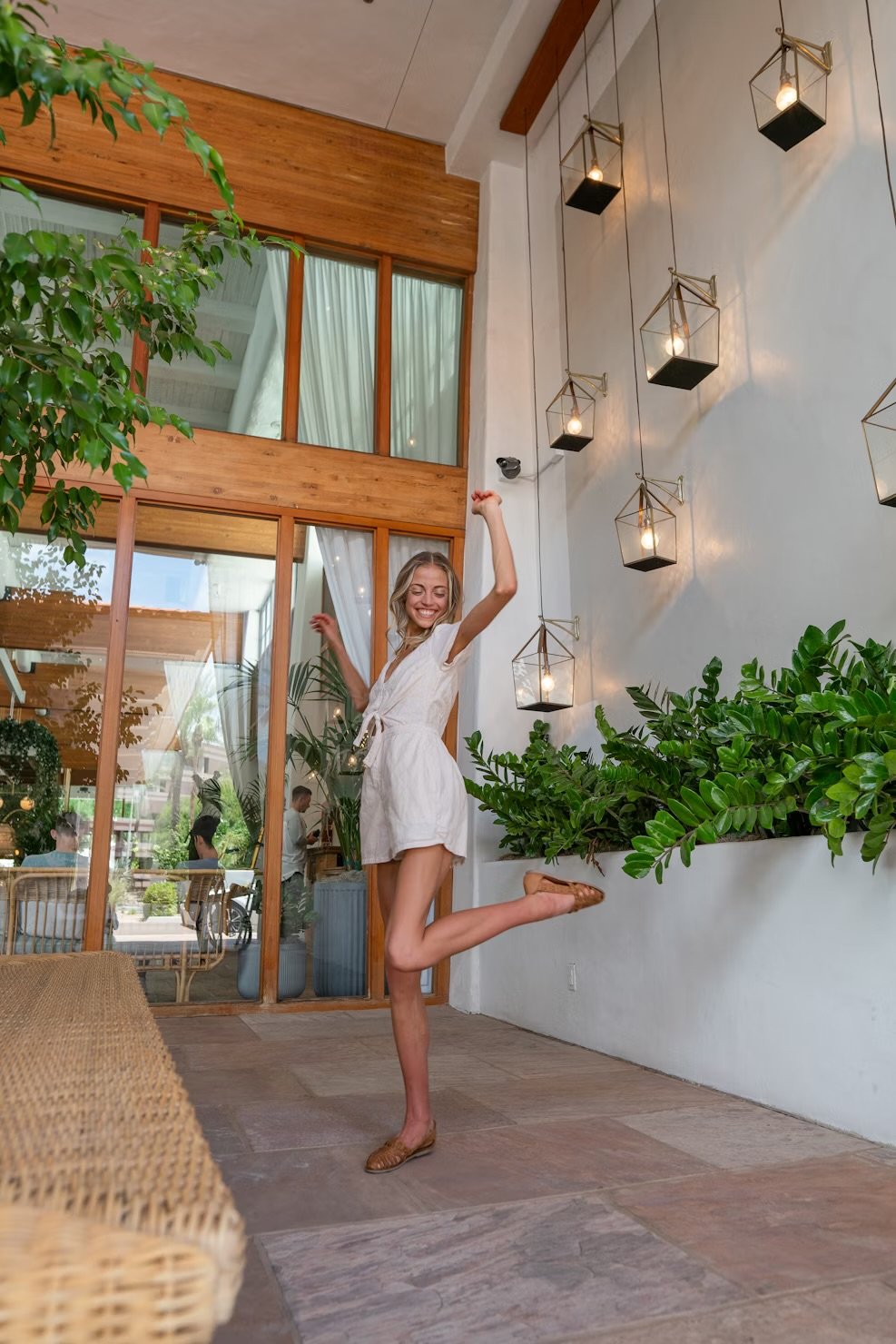Disclaimer: I’m not a mental health professional, everything here is shared from research and personal experience. If you’re feeling overwhelmed or need support, please consider talking to a qualified professional. You’re not alone. If you’re in the U.S., you can call or text 988 anytime. For help in other countries, visit https://findahelpline.com.
We all know that exercise is good for the body. But what often gets overlooked is how powerfully it shapes the brain, sometimes in just a few minutes. If you’ve ever gone for a walk after feeling anxious and noticed the tension lifting, you’ve experienced this firsthand.
The good news? You don’t need long, sweaty gym sessions to change your brain chemistry. Short, intentional movements; like walking, yoga, or even shaking out your body, can quickly calm anxiety and boost your mood. This guide explores how exercise relieves stress, why it works on a brain level and simple routines you can add to your day.
Why Exercise Works for Anxiety Relief
Anxiety often makes your body feel “on edge”: racing thoughts, shallow breathing, tense muscles. Movement helps because it taps into your nervous system, hormones and even brain structure. Here’s what happens when you move:
- Stress hormones drop. Exercise lowers cortisol and adrenaline, the two main stress chemicals that keep your body in fight-or-flight mode [1].
- Your brain makes more endorphins. These natural feel-good chemicals work like mini mood-boosters, leaving you calmer and more grounded [2].
- The brain rewires itself. Regular movement stimulates neuroplasticity (the brain’s ability to adapt) especially in areas linked to anxiety and mood [3].
- You breathe better. Many short practices focus on breath, which signals your nervous system to shift into a more relaxed state [4].
You don’t have to “go big” to get these benefits. Even a few minutes of mindful movement can begin changing how your brain and body respond to stress.

Quick Practices That Help Calm Anxiety
1. Walking: The Simplicity of Forward Motion
Walking might sound almost too simple, but it’s one of the most researched methods for reducing anxiety. Studies show that walking, especially at a gentle to moderate pace, lowers stress hormones and improves mood regulation [5].
The act of moving forward also gives your brain a sense of progress, which helps when your thoughts feel stuck in loops of worry.
Try this:
- Step outside if possible, or walk indoors.
- Go for 5–10 minutes.
- Match your steps to slow, steady breathing.
- If your mind races, gently bring attention back to your feet touching the ground.
Even a short walk between tasks can reset your stress response and help you think more clearly.
2. Yoga: Balancing the Body and Mind
Yoga is known for combining movement with breath, which makes it especially powerful for anxiety. Research shows that yoga practices reduce overactivity in the sympathetic nervous system (the “fight-or-flight” side) and boost parasympathetic activity (the “rest-and-digest” side) [6].
What makes yoga effective isn’t just stretching: it’s the mindful, intentional awareness of your body. This lowers both physical and mental tension.
Try this 5-minute calming flow:
- Child’s Pose (Balasana) – Rest here for 1 minute, breathing deeply.
- Cat-Cow (Marjaryasana/Bitilasana) – Flow gently between these poses for 1–2 minutes.
- Forward Fold (Uttanasana) – Hinge at the hips, letting your arms hang, for 30 seconds.
- Seated Breathing – Sit cross-legged, one hand on your belly, and inhale for 4 counts, exhale for 6 counts.
This micro-practice calms the body, slows the breath and helps the brain shift out of anxious overdrive.

3. Shaking: A Release for Stuck Tension
This one might surprise you: intentionally shaking your body is an ancient practice that’s gaining more and more attention. Animals shake instinctively after stress to discharge energy. Humans can do the same.
Somatic therapists suggest shaking to reset the nervous system and release muscular tension linked to anxiety [7].
Try this 3-minute shake-out:
- Stand with feet hip-width apart.
- Start bouncing gently through your knees.
- Let your arms, shoulders, and hands loosen.
- Gradually shake your whole body, from head to toe.
- Finish by standing still, noticing the sensation of release.
It may feel strange at first, but many people report feeling lighter, calmer and more grounded afterward.
4. Breath + Movement Mini Practices
Sometimes the most powerful exercises combine breath with gentle movement. For example:
- Box Breathing with Arm Raises
Inhale and raise your arms for 4 counts → hold for 4 counts → exhale and lower arms for 4 counts → hold for 4 counts. Repeat 5 rounds. - Progressive Muscle Release
Tighten one muscle group (shoulders, fists, etc.) for 5 seconds → exhale and release. Move through your body.
These techniques link body and breath, teaching your nervous system to downshift more quickly when stress hits.
How to Build a Routine That Sticks
Consistency matters more than intensity. A little daily movement can add up to a huge impact over time. Here’s how to keep it realistic:
- Start with 5 minutes. It’s better to do short daily practices than push for long workouts that you’ll skip.
- Link it to habits you already have. Shake while waiting for the kettle to boil, walk after lunch, or do yoga before bed.
- Track your mood shifts. Notice how you feel before and after. Even small differences (less tense shoulders, clearer mind) are proof it’s working.
- Mix it up. Try walking one day, yoga another and shaking when you’re restless. Variety keeps it fresh.
- Focus on how you feel, not calories burned. This is about nervous system health, not numbers.
When to Use Movement as a Tool
Think of these practices as tools in your pocket. You can use them:
- In the morning to start the day calm and focused.
- During work breaks when stress builds.
- Before bed to help your brain settle down.
- After triggering events to release anxiety instead of carrying it.
Over time, your brain learns that movement is a reliable way to feel safe again.

Final Thoughts
If anxiety feels overwhelming, it’s comforting to know that the body itself can help calm the mind. Simple movement practices are a fast, accessible way to reduce stress, regulate your nervous system and create lasting changes in your brain.
Start small, experiment with what feels good and let these moments of movement become anchors of calm in your day.
Sources
[1] Harvard Health Publishing. Exercising to Relax. https://www.health.harvard.edu/staying-healthy/exercising-to-relax
[2] Mayo Clinic. Exercise and stress: Get moving to manage stress. https://www.mayoclinic.org/healthy-lifestyle/stress-management/in-depth/exercise-and-stress/art-20044469
[3] Erickson, K. I., et al. (2011). Exercise training increases size of hippocampus and improves memory. PNAS. https://doi.org/10.1073/pnas.1015950108
[4] National Center for Complementary and Integrative Health. Yoga: What You Need To Know. https://www.nccih.nih.gov/health/yoga-what-you-need-to-know
[5] Robertson, R., et al. (2012). Walking for depression or depressive symptoms: A systematic review and meta-analysis. Mental Health and Physical Activity, 5(1), 66–75.
[6] Streeter, C. C., et al. (2012). Effects of yoga on the autonomic nervous system, gamma-aminobutyric-acid, and allostasis in epilepsy, depression, and post-traumatic stress disorder. Medical Hypotheses, 78(5), 571–579.
[7] Levine, P. A. (1997). Waking the Tiger: Healing Trauma. North Atlantic Books.


I really enjoyed this! I love exercising because it makes me feel so good afterwards, and I know it’s doing my body good. Being older, I’m trying to do everything I can to stay healthy, and movement definitely helps calm my mind. I can totally relate to that “on edge” feeling from anxiety, but even just a short workout or a walk makes such a difference. It’s amazing how our bodies respond once we get moving.
Love this. Pilates and meditation are my go to’s but shaking sounds fun!
I enjoy going for walks to help reduce stress and anxiety, but I’m excited to try shaking for movement too, that sounds like a great idea! Exercising after a stressful trigger is a good tip, that would help me calm myself down. Thanks for the suggestions!
I have almost gotten into a routine. I woke up one day last year and couldn’t walk. After almost a year of physical therapy I’m almost back to my old self. I wish I could walk more, but yoga helps with stretching. Did you know issues with your back will also affect your feet? I learned that the hard way.